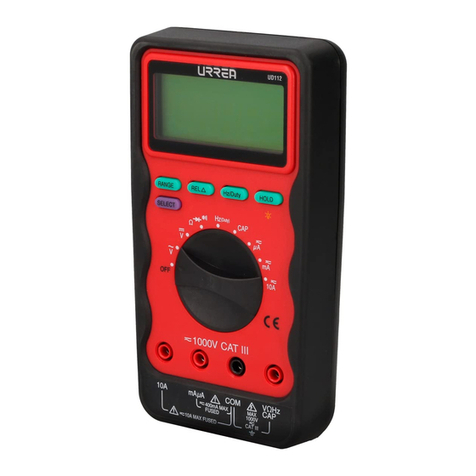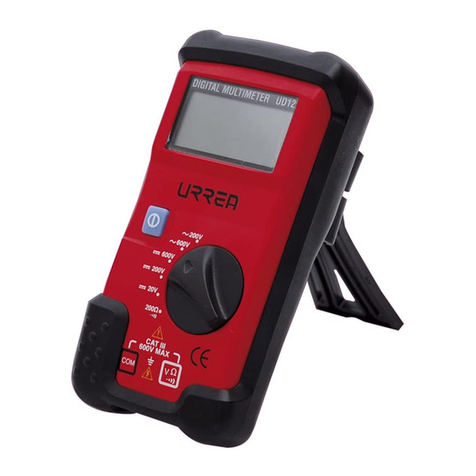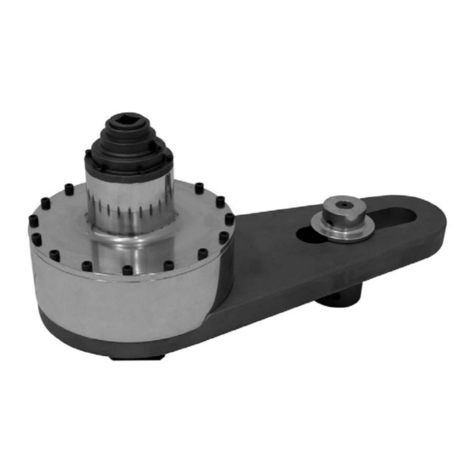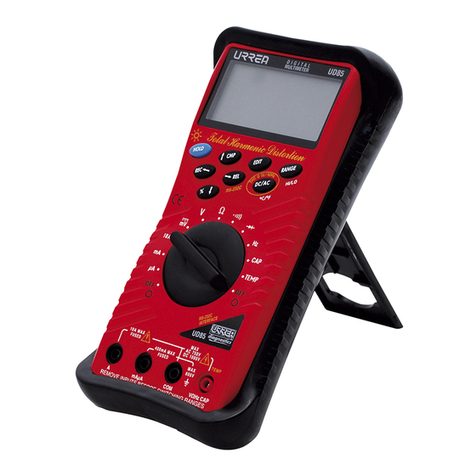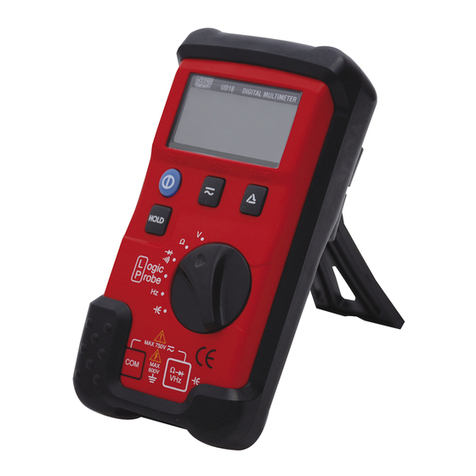
ESPAÑOL
5
14. Aparece cuando el botón “Hold”
es activado.
15. Polaridad negativa. Indica
automáticamente la polaridad
invertida.
16. Batería baja. Indicador de que
la batería se ha agotado. Cuando
aparece por primera ocasión, restan
al menos 8 horas de vida a la batería.
Reemplace la batería inmediatamente.
Nunca deje una batería descargada o
con poca carga dentro del medidor. Aún
baterías a prueba de fisuras pueden
gotear y dañar el medidor.
17. Indicador de sobrecarga. Mostrado
en la pantalla LCD cuando la entrada es
muy grande para ser mostrada.
Utilizando las puntas de prueba.
Utilice únicamente el mismo tipo de puntas
de prueba como han sido proporcionadas
con el medidor. Estas puntas están
aprobadas para 1200 Volts, no trate de
medir ningún voltaje mayor a 1000 Volts CD
o 750 Volts CA.
NOTA: En algunos rangos de voltajes CA o
CD con las puntas de prueba no conectadas
en ningún circuito, la pantalla podría
mostrar lecturas fluctuantes debido a la alta
impedancia de entrada. Esto es normal.
Cuando conecte las puntas de prueba al
circuito, la medicón real aparece.
Usando la funda de protección.
El medidor viene con una funda protectora
que absorbe los golpes y protege el medidor
del uso rudo. La funda está equipada con
una base para piso.
4. PRUEBAS Y MEDICIONES
ELÉCTRICAS BÁSICAS
4.1 Medición de voltaje.
ADVERTENCIA: PARA EVITAR EL RIESGO
DE UNA DESCARGA ELÉCTRICA O DAÑO
AL APARATO, LOS VOLTAJES NO DEBEN
EXCEDER 1000V CD O 750V CA (RMS).
NO INTENTE TOMAR MEDICIONES EN
NINGÚN VOLTAJE DESCONOCIDO QUE
PUEDA EXCEDER LOS 1000V CD O 750V
CA (RMS). ESTE MEDIDOR ESTA DISEÑADO
PARA MEDIR CORRIENTE EN CIRCUITOS DE
BAJA ENERGÍA. NO LO USE PARA MEDIR
CIRCUITOS DE ALTA ENERGÍA (LÍNEAS DE
POTENCIA EN FÁBRICAS Y POR LO TANTO
CON GRAN CAPACIDAD DE CORRIENTE).
RESULTA PELIGROSO UTILIZARLO EN
CIRCUITOS DE ALTA CORRIENTE, DEBIDO A
QUE LOS FRECUENTES PICOS DE VOLTAJE
EXCEDEN LA CAPACIDAD DEL APARATO.
NOTA: Cuando se tomen mediciones de
voltaje, este medidor debe ser conectado en
PARALELO con el circuito o el elemento de
circuito bajo prueba.
•En el rango de 200mV el valor mostrado
puede fluctuar cuando se desconectan las
terminales de entrada. Esto es normal.
•El circuito de medición de voltaje CA
de este medidor es un sistema de valor
medio, por lo tanto una forma de onda
CA diferente a una onda senoidal causa
errores.
•Para mejorar la precisión en las mediciones
de voltajes CD tomadas en presencia de
voltajes CA (como al medir el voltaje CD
“offset” de un amplificador en presencia
de una señal de CA) Mida el voltaje






